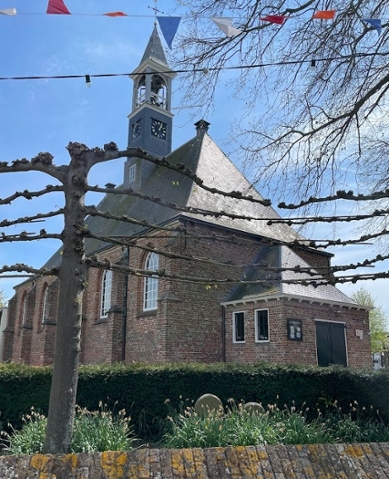
Slice of 'Zeeuws' life: the complex stories behind human burials in Koudekerke
A team of three students affiliated with Leiden University is shedding new light on the lives, diets, health, and mobility of individuals buried at the historic church site in Koudekerke, Zeeland. The project, a collaboration with the Walcherse Archeologische Dienst and funded by the Municipality of Veere, examines human skeletal remains excavated in 2019. The interdisciplinary study is uncovering complex stories from the Late Middle Ages to the early 20th century. Leiden-based archaeologists Dr Letty ten Harkel, Dr Jason Laffoon and Dr Rachel Schats supervise the three students.

Radiocarbon dating
Student Lieke focused on radiocarbon dating and dietary reconstruction through stable isotope analysis. ‘Originally, we believed the site represented four distinct burial phases,’ she explains. ‘But radiocarbon dating of one individual from each stratigraphic layer revealed a different picture.’ The three lower layers all dated to the 13th–14th centuries, while only the uppermost burial dated to the modern era—possibly between the late 17th and early 20th century. This was consistent with historical records that indicate burials at the church ceased after 1869.
Lieke’s dietary isotope analysis used carbon and nitrogen values extracted from bone and dentine collagen, comparing molars and bone samples to track dietary changes from childhood into adulthood. The results revealed variations in protein sources, likely tied to environmental and cultural factors, such as the consumption of marine-based foods or meat from sheep grazing on salt marshes. ‘We’re combining this with mobility isotope data, not just strontium and oxygen but also sulfur,’ she says. ‘Sulfur isotopes provide information on both diet and mobility, and their analysis has only rarely been applied in Dutch archaeology before. Together with our multi-sample approach, this methodology is very innovative.’
Labor-related pathologies
Rachel, a master’s student in Archaeology, is focusing on vertebral pathologies as a proxy for physical stress and labor. ‘I’m looking at spinal lesions, specifically Schmorl’s nodes and signs of wear,’ she says. ‘These are often caused by heavy lifting or sustained bending.’ Despite the small number of individuals, 18 in total, Rachel has already observed a high prevalence of spinal degeneration, suggesting physically demanding lifestyles.
Her research aims to contribute to broader questions about labor patterns, health conditions, and social status, comparing Koudekerke to a coastal community from Zeeland, Klaaskinderkerke. ‘We’re trying to read between the bones, so to speak, to understand the lived experiences of these people,’ she adds.
Tracing migration patterns
Bjorn is using strontium and oxygen isotope analysis to investigate mobility. ‘By analysing tooth enamel, which forms in childhood, we can determine whether individuals were local or came from elsewhere,’ he explains. The oxygen results are still pending, but the strontium results alone already provide interesting insights. ‘We compare isotope values from the teeth to local baselines. If they fall outside those expected ranges, it suggests migration.’
The study’s broader aim is to reconstruct the social history of Koudekerke and understand how this Zeeland community fit into regional patterns of mobility during the Late Middle Ages. ‘ All but one individual have a non-local strontium signal. Based on the strontium isoscape of the Netherlands by Kootker et al. (2016), all of the Netherlands, excepts eastern Limburg, can be excluded as possible place of origins. Where these individuals might have come from, still needs further investigation. it may reflect connections with areas such as modern-day Belgium or the UK,’ says Bjorn. ‘That would offer fascinating insights into movement across the Scheldt region.’

Preserving the past
The skeletal collection, currently on loan to Leiden University, will eventually be returned to the region. As research continues, the work of Lieke, Rachel, and Bjorn contributes to a richer understanding of Koudekerke’s past, its people, their origins, their hardships, and their diets, offering a glimpse into the daily lives of those who once lived and died in this historic Dutch village. When all analyses are done, they aim to produce a jointly-authored publication to make the results available to the wider community.
